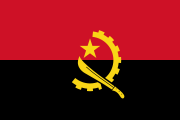Mikoyan-Gurevich MiG-17
| Mikoyan-Gurevich MiG-17 | |
|---|---|
 |
|
| Restored MiG-17 in the markings of the Polish Air Force | |
| Role | Fighter aircraft |
| National origin | Soviet Union |
| Manufacturer | Mikoyan-Gurevich |
| First flight | 14 January 1950 |
| Introduced | October 1952 |
| Status | Retired |
| Primary users | Soviet Air Force PLA Air Force Polish Air Force Vietnam People's Air Force |
| Number built | 10,367 |
| Developed from | Mikoyan-Gurevich MiG-15 |
| Variants | PZL-Mielec Lim-6 Shenyang J-5 |
The Mikoyan-Gurevich MiG-17 (Russian: Микоян и Гуревич МиГ-17) (NATO reporting name: Fresco) (China:Shenyang J-5) (Poland: PZL-Mielec Lim-6)[1] is a high-subsonic performance jet fighter aircraft produced in the USSR from 1952 and operated by numerous air forces in many variants. It is an advanced development of the very similar appearing MiG-15 of the Korean War, and was used as an effective threat against supersonic fighters of the United States in the Vietnam War. It was also briefly known as the "Type 38", by USAF designation prior to the development of NATO codes.[2]
Contents |
Development
The MiG-17 is a ground-attack version of the previously successful Mikoyan and Gurevich fighter, the MiG-15. It is also capable of air-to-air combat with its guns.[3] The major innovation was the introduction of a swept wing with a "compound sweep" configuration: a 45° angle near the fuselage, and a 42° angle for the outboard part of the wings. Other easily visible differences to its predecessor were the three wing-fences on each wing, instead of the MiG-15's two, and the addition of a ventral fin. The MiG-17 shared the same Klimov VK-1 engine and the rest of its construction was similar.[3] The first prototype, designated "SI" by the construction bureau, was flown on the 14 January 1950, piloted by Ivan Ivashchenko.
Despite the SI prototype's crash on 17 March 1950, tests of another prototype "SI-2" and experimental series aircraft "SI-02" and "SI-01" in 1951, were generally successful, and on 1 September 1951 the aircraft was accepted for production. It was estimated that with the same engine as the MiG-15's, the MiG-17's maximum speed is higher by 40–50 km/h, and the fighter has greater manoeuvrability at high altitude.
Serial production started in August 1951. During production, the aircraft was improved and modified several times. The basic MiG-17 was a general-purpose day fighter, armed with three cannons. It could also act as a fighter-bomber, but its bombload was considered light relative to other aircraft of the time, and it usually carried additional fuel tanks instead of bombs.
The second prototype variant, "SP-2", was an interceptor equipped with a radar. Soon a number of MiG-17P all-weather fighters were produced with the Izumrud radar and front air intake modifications. In early 1953 the MiG-17F day fighter entered production. Fitted with the VK-1F engine with an afterburner, which improved its performance, it became the most popular variant of the MiG-17. The next mass-produced variant with afterburner and radar was the MiG-17PF. In 1956 a small series (47 aircraft) was converted to the MiG-17PM standard (also known as PFU) with four first-generation Kaliningrad K-5 (NATO reporting name AA-1 'Alkali') air-to-air missiles. A small series of MiG-17R reconnaissance aircraft were built with VK-1F engine (after first being tested with the VK-5F engine).
Several thousand MiG-17s were built in the USSR by 1958.
Design
Day-fighter variants (MiG-17, MiG-17F) were armed with two 23 mm NR-23 cannons (80 rpg) and one 37 mm N-37 cannon (40 rounds), which were mounted on a common bed under the central air intake. The gun bed could be easily wound down for maintenance. On radar-equipped variants (MiG-17P, MiG-17PF), the 37 mm N-37 was replaced with a third 23 mm NR-23 (carrying 100 rpg) to compensate for the weight aft of the radar. All variants could carry 100 kg (220 lb) bombs on two underwing pylons and some could carry 250 kg (551 lb) bombs; however, these pylons were usually used for 400 l (106 US gal) fuel tanks. The MiG-17R was armed with two 23 mm cannons. Most MiG-17s in third world service today fly as ground attack or trainer aircraft.
The only variant with air-to-air missiles was the MiG-17PM (or MiG-17PFU), which could carry four K-5 (NATO: AA-1 "Alkali"). It had no cannons. Some countries occasionally modified their MiG-17s to carry unguided rockets or bombs on additional pylons. MiG-17s in Cuba could be armed with AA-2 "Atoll" missiles.
The MiG-17P was equipped with the Izumrud-1 (RP-1) radar, while the MiG-17PF was initially fitted with the RP-1 which was later replaced with the Izumrud-5 (RP-5) radar. The MiG-17PM was also equipped with a radar, used to aim its missiles. Other variants had no radar.
Licence production


In 1955, Poland received a license for MiG-17 production. The MiG-17F was produced by the WSK-Mielec factory under the designation Lim-5. The first Lim-5 was built on 28 November 1956 and 477 were built by 1960. An unknown number were built as the Lim-5R reconnaissance variant, fitted with the AFA-39 camera. In 1959–1960, 129 MiG-17PF interceptors were produced as the Lim-5P. PZL-WSK also developed several Polish attack plane variants based on the MiG-17: the Lim-5M, produced from 1960; Lim-6bis, produced from 1963; and Lim-6M (converted in the 1970s); as well as two reconnaissance variants: the Lim-6R (Lim-6bisR) and MR.
In China, an initial MiG-17F was assembled from parts in 1956, with license production following in 1957 at Shenyang. The Chinese-built version is known as the Shenyang J-5 (for local use) or F-5 (for export). According to some sources, earlier MiG-17s which had been delivered directly from the USSR were designated "J-4". From 1964, the Chinese produced a radar-equipped variant similar to the MiG-17PF, which was known as the J-5A (F-5A). The Chinese also developed a two-seat trainer variant, the JJ-5 (FT-5 for export), which integrated the cabin of the JJ-2 (a license-built MiG-15UTI) with the J-5. It was produced in 1966-1986, being the last-produced MiG-17 variant and its only twin-seater variant. The Soviets did not produce a two-seat MiG-17 as they felt that the training variant of the older MiG-15 was sufficient.
Many Soviet and licence-built examples remain in service to this day, though not all are currently active, making the MiG-17 one of the longest serving fighters ever built.
Operational history

Vietnam War MiGs were designed to intercept straight and level flying enemy bombers, not for air to air combat (Dog-fighting) with other fighters.[4] This subsonic (.93 Mach) fighter was effective against slower (.6-.8 Mach), heavily loaded US fighter-bombers, as well as the mainstay American strategic bombers during the MiG-17's development cycle (such as the Boeing B-50 Superfortress or Convair B-36 Peacemaker, which were both still powered by piston engines). Even if the target had sufficient warning and time to shed weight and drag by dropping external ordnance and accelerate to supersonic escape speeds, doing so would have inherently forced the enemy aircraft to abort its bombing mission. By the time the USAF introduced strategic bombers capable of cruising at supersonic speeds such as the Convair B-58 Hustler and General Dynamics FB-111, however, the MiG-17 became obsolete in PVO service and was supplanted by supersonic interceptors such as the MiG-21 and MiG-23.
MiG-17s were not available for the Korean War, but saw combat for the first time over the Straits of Taiwan when PRC (Communist China) MiG-17s clashed with ROC (Nationalist China) F-86 Sabres in 1958.
Vietnam War
In 1960, the first group of approximately 50 North Vietnamese airmen were transferred to Communist China to begin transitonal training onto the MiG-17. By this time the first detachment of Chinese trained MiG-15 pilots had returned to North Vietnam, and a group of 31 airmen were deployed to Communist China's base at Son Dong for conversion to the MiG-17. By 1962 the first North Vietnamese pilots had finished their MiG-17 courses in the Soviet Union and Red China, and returned to their units; to mark the occasion, the Soviets sent as a "gift" 36 MiG-17 fighters and MiG-15UTI trainers to Hanoi in February 1964. These airmen would create North Vietnam's first jet fighter regiment, the 921st.[5] By 1965, another group of MiG pilots had returned from training in Krasnodar, in the USSR, as well as from Red China. This group would form North Vietnam's second fighter unit, the 923rd Fighter Regiment. While the newly created 923rd FR operated strictly MiG-17s, the 921st FR would operate both MiG-17s and MiG-21s (in 1969 the 925th FR MiG-19 unit would be formed).[6]
Although US jet fighter-bombers (the North American F-100 Super Sabre and McDonnell F-101 Voodoo) had been engaged in combat since 1961,[7] the North Vietnamese Air Force MiGs had not. On 4 April 1965, the USAF conducted a "re-strike" on the Hàm Rồng/Thanh Hoa bridge with 48 Republic F-105 Thunderchiefs loaded with 384 x 750 lb bombs. The Thunderchiefs were escorted by a MiGCAP flight of F-100 Super Sabres from the 416th Tactical Fighter Squadron (TFS). Coming from above, four MiG-17s from the 921st Fighter Regiment (FR) tore through the escorts and dove onto the Thunderchiefs, shooting two of them down. The Super Sabres engaged with one firing a "AIM-9 Sidewinder" air-to-air missile which apparently missed (or malfunctioned),[8] and another F-100 fired 20mm cannons, which also apparently missed. The North Vietnamese MiG-17s had scored their first confirmed aerial victories in jet-to-jet combat (North Vietnamese MiG-17s and US jets had fought their first jet air battle on 3 April 1965 which involved US Navy Vought F-8 Crusaders, with only probable kills)[9].
The USAF confirmed the two F-105 losses during that engagement, and an F-100 piloted by CPT Donald W. Kilgus reported a probable aerial victory over one of the MiG-17s, but no other US airmen reported any confirmed aerial kills during the air battle. However, MiG-17 pilot Tran Hanh, who was credited with one confirmed F-105 victory during that engagement, stated that three of his accompanying MiG-17s had been shot down by the opposing USAF fighters.[10]
During the 4 April 1965 engagement, four MiG-17s from the 921st FR had tangled with over 50 US jet fighter-bombers, consisting of F-105s and F-100s.[8] Three F-100s from the MiGCAP, piloted by LTC Emmett L. Hays, CPT Keith B. Connolly,[8] and CPT Donald W. Kilgus, all from the 416th TFS,[11] engaged the MiG-17s. One Super Sabre fired an air-to-air missile and Connolly and Kilgus engaged with 20mm cannon, with only Kilgus claiming a probable kill. The four attacking MiGs from the 921st FR were flown by Flight Leader Tran Hanh, Wingman Pham Giay, Le Minh Huan and Tran Nguyen Nam.[12] Flight Leader Tran Hanh was the only survivor from the air battle and reportedly stated that his three MiG-17s were "... shot down by the F-105s."[10] Based upon the report, the USAF F-100s very well could have been mistaken for F-105s, and the reported loss of three MiG-17s to those mistaken jet fighters[13] would indicate that the USAF North American F-100 Super Sabres had obtained the first US aerial combat victories during the Vietnam War.
The MiG-17 was not originally designed to function as a fighter-bomber, but in 1971 Hanoi directed that US Navy warships were to be attacked by elements of the North Vietnamese Air Force. This would require the MiG-17 to be fitted with bomb mountings and release mechanisms. Chief Engineer of the NVAF ground crews, Truong Khanh Chau,[14] was tasked with the mission of modifying two MiG-17s for the ground attack role; after three months of work, the two jets were ready. On 19 April 1972, two pilots from the 923rd FR took their bomb laden MiG-17s and attacked the US Navy destroyer USS Higbee (DD-806) and light cruiser USS Oklahoma City (CLG-5). Each MiG was armed with two 250 kg (550 lb) bombs. Pilot Le Xuan Di managed to hit the destroyer's aft 5" gun mount, destroying it, but inflicting no fatalities, as the crewmen had vacated the turret earlier due to a malfunction with the gun system.[15] The other attacker from the two-plane sortie was flown by Nguyen Van Bay, an airman who would later end the war with seven confirmed air victories, all accomplished with his MiG-17. On this day however, his fighter either managed to slightly damage the USS Oklahoma City, or miss it entirely, depending upon the source. Each pilot had completed their drop of two bombs each and returned to base. After the war, Truong Khanh Chau became the director of the Vietnam Institute for Science and Technology in 1977.
The MiG-17 was the primary interceptor of the fledgling Vietnam People's Air Force in 1965, scoring its first aerial victories and seeing extensive combat during the Vietnam War, the aircraft frequently worked in conjunction with MiG-21s and MiG-19s. Many historians believe that some North Vietnamese pilots, in fact, preferred the MiG-17 over the MiG-21 because it was more agile, though not as fast; however, of the 16 NVAF Aces of the war, 13 of them attained that status while flying the MiG-21. Only three North Vietnamese Airmen gained Ace status while flying the MiG-17.
From 1965 to 1972, MiG-17s from the NVAF 921st and 923rd FRs would claim 71 aerial victories against US aircraft: 11 Crusaders; 16 F-105 Thunderchiefs; 32 McDonnell Douglas F-4 Phantom IIs; two Douglas A-4 Skyhawks; seven Douglas A-1 Skyraiders (propeller driven strike aircraft); one C-47 cargo/transport aircraft; one Sikorsky CH-3C helicopter; and one Ryan Firebee UAV.[16]
The American fighter community was shocked in 1965 when elderly, subsonic MiG-17s downed sophisticated Mach-2-class F-105 Thunderchief fighter-bombers over North Vietnam. To redress disappointing combat performance against smaller, more agile fighters like the MiGs, the Americans established dissimilar air combat training (DACT) in training programs such as "TOPGUN", which employed subsonic Douglas A-4 Skyhawk aircraft to mimic more manoeuvrable opponents such as the MiG-17. The US Navy also set Adversary squadrons equipped with the nimble A-4 at each of its fighter and attack Master jet bases to provide DACT.
Other MiG-17 users
MiG-17s were sold and/or imported to many Middle Eastern countries and saw action in nearly all of the Arab-Israeli conflicts starting when 12 of them served with the Egyptian Air Force during the Suez Crisis of 1956, plus hundreds more served, and were mostly destroyed, in the Egyptian and Syrian Air Forces during the Six-Day War of 1967 as well as the War of Attrition, the 1973 Yom Kippur War, and the 1982 Israeli Invasion of Lebanon.
At least 24 of them served with the Nigerian Air Force and were flown by a mixed group of local Nigerian and mercenary pilots from East Germany, Soviet Union, South Africa, the United Kingdom, and Australia during the 1967-70 Nigerian Civil War. Four were hurriedly supplied by the USSR to Sri Lanka during the 1971 insurgency and were used for bombing and ground attack in that conflict. Four North Korean Mig-17 aircraft were involved in the EC-121 shootdown incident, where they managed to shoot down an American EC-121 Warning Star. Similarly in 1958, a USAF Lockheed C-130 was shot down by four MiG-17 fighters when it flew into Soviet airspace near Yerevan, Armenia while on a Sun Valley SIGINT mission, with all 17 crew killed.
Twenty countries flew MiG-17s. The MiG-17 became a standard fighter in all Warsaw Pact countries in the late 1950s and early 1960s. They were also bought by many other countries, mainly in Africa and Asia, that were neutrally aligned or allied with the USSR. The MiG-17 still flies today in the air forces of Burkina Faso, China (JJ-5 Trainer) Mali, Mozambique, North Korea, Pakistan, Republic of the Congo, Somaliland, Sudan, and Tanzania.
Variants
- I-300
- Prototype.
- MiG-17 (Fresco-A)
- Basic fighter version powered by VK-1 engine ("aircraft SI").
- MiG-17A
- Fighter version powered by VK-1A engine with longer lifespan.
- MiG-17AS
- Multirole conversion, fitted to carry unguided rockets and the K-13 air to air missile.
- MiG-17P (Fresco-B)
- All-weather fighter version equipped with Izumrud radar ("aircraft SP").
- MiG-17F (Fresco-C)
- Basic fighter version powered by VK-1F engine with afterburner ("aircraft SF").
- MiG-17PF (Fresco-D)
- All-weather fighter version equipped with Izumrud radar and VK-1F engine ("aircraft SP-7F").
- MiG-17PM/PFU (Fresco-E)
- Fighter version equipped with radar and K-5 (NATO: AA-1 'Alkali') air-to-air missiles ("aircraft SP-9").
- MiG-17R
- Reconnaissance aircraft with VK-1F engine and camera ("aircraft SR-2s")
- MiG-17SN
- Experimental variant with twin side intakes, no central intake, and nose redesigned to allow 23 mm cannons to pivot to engage ground targets. Not produced.
- Shenyang J-5
Some withdrawn aircraft were converted to remotely controlled targets.
Operators
 Afghanistan
Afghanistan- Afghan Air Force. Around 100 MiG-17F acquired by the Afghan Air Force from 1957.
 Albania
Albania- Albanian Air Force - 20 aircraft, including 8 Chinese-made JJ-5 trainers, were acquired. All Albanian fighters are in storage, retired from active service, due to lack of spare parts
 Algeria
Algeria- Algerian Air Force
 Angola
Angola- People's Air and Air Defence Force of Angola.
 Bangladesh
Bangladesh- Bangladeshi Air Force
 Bulgaria
Bulgaria- Bulgarian Air Force
 Burkina Faso
Burkina Faso Cambodia
Cambodia- Royal Cambodian Air Force - possibly in storage
 China
China- see also Shenyang J-5
- People's Liberation Army Air Force
- People's Liberation Army Navy Air Force. J-5 trainers still in limited service. Single seat fighters have been retired and sold to other countries.
 Republic of the Congo
Republic of the Congo- Congolese Air Force
 Cuba
Cuba- Cuban Air Force
 Czechoslovakia
Czechoslovakia- Czechoslovakian Air Force - 2 MiG-17F for evaluation purposes (EP-01 and EP-02), 34 MiG-17PF all-weather interceptors. All retired before 1970.
 East Germany
East Germany- East German Air Force
 Egypt
Egypt- Egyptian Air Force
 Ethiopia
Ethiopia- Ethiopian Air Force. All retired.
 Guinea
Guinea Guinea-Bissau
Guinea-Bissau Indonesia
Indonesia- Indonesian Air Force - Using MiG-17F and MiG-17PF. All of the aircraft acquired in 1961. Used during the preparation of Operation TRIKORA in 1962 to retake Western New Guinea, now Papua and Papua Bara, from the Netherlands. Some of the aircraft were used intensively in Air Forces / TNI-AU Acrobatic Team in 1962 for air show events around Indonesia. All aircraft were grounded in 1969. None have been in service since 1970.
 Iraq
Iraq- Iraqi Air Force
 Hungary
Hungary- Hungarian Air Force
 Libya
Libya- Libyan Air Force
 Madagascar
Madagascar Mali
Mali- MiG-17 in service.
 Mongolia
Mongolia- Mongolian Air Force - Between in 1970-1977 received than 17 aircraft
 Morocco
Morocco- Royal Moroccan Air Force
 Mozambique
Mozambique- MiG-17 in service.
 Nigeria
Nigeria- Nigerian Air Force
 North Korea
North Korea- North Korean Air Force - J-5 still in service.
 Pakistan
Pakistan- Pakistan Air Force
 Poland
Poland- Polish Air Force
 Romania
Romania- Romanian Air Force - 12 MiG-17PF and 12 MiG-17F entered service in 1955 and 1956, respectively.
 Somalia
Somalia- Somali Air Corps
 Somaliland
Somaliland Soviet Union
Soviet Union
- Soviet Air Force
- Soviet Naval Aviation
- Soviet Anti-Air Defence
 Sri Lanka
Sri Lanka- Sri Lankan Air Force - All retired from service.
 Sudan
Sudan- Sudanese Air Force - MiG-17 and J-5 still in service
 Syria
Syria- Syrian Air Force
 Tanzania
Tanzania- Tanzanian Air Force - J-5 in service.
 Uganda
Uganda- Ugandan Air Force
 Vietnam
Vietnam- Vietnam People's Air Force
 Yemen
Yemen- Yemen Air Force
 Zimbabwe
Zimbabwe- Air Force of Zimbabwe
Specifications (MiG-17F)
Blueprints:[1]
General characteristics
- Crew: One
- Length: 11.36 m (37 ft 3 in)
- Wingspan: 9.63 m (31 ft 7 in)
- Height: 3.80 m (12 ft 6 in)
- Wing area: 22.6 m² (243.2 ft²)
- Empty weight: 3,930 kg (8,646 lb)
- Loaded weight: 5,354 kg (11,803 lb)
- Max takeoff weight: 6,286 kg (13,858 lb)
- Powerplant: 1× Klimov VK-1F afterburning turbojet, 33.1 kN with afterburner (7,440 lbf)
Performance
- Maximum speed: 1,144 km/h at 3,000 m (711 mph at 10,000 ft (3,000 m))
- Range: 1,080 km, 1,670 km with drop tanks (670 mi / 1,035 mi)
- Service ceiling: 16,600 m (54,500 ft)
- Rate of climb: 65 m/s (12,795 ft/min)
- Wing loading: 237 kg/m² (48 lb/ft²)
- Thrust/weight: 0.63
Armament
- 1x 37 mm Nudelman N-37 cannon (40 rounds total)
- 2x 23 mm Nudelman-Rikhter NR-23 cannons (80 rounds per gun, 160 rounds total)
- Up to 500 kg (1,100 lb) of external stores on two pylons, including 100 kg (220 lb) and 250 kg (550 lb) bombs, unguided rockets or external fuel tanks.
- (some versions of MiG-17F equipped with 3x NR-23 cannons)
See also
Related development
- Mikoyan-Gurevich MiG-15
- PZL-Mielec Lim-6
- Shenyang J-5
Comparable aircraft
- F-86 Sabre
- Dassault Mystère IV
- Hawker Hunter
Related lists
- List of military aircraft of the Soviet Union and the CIS
- List of fighter aircraft
References
- Notes
- ↑ Parsch, Andreas and Aleksey V. Martynov. "Designations of Soviet and Russian Military Aircraft and Missiles."Non-U.S. Military Aircraft and Missile Designations, revised 18 January 2008. Retrieved: 30 March 2009.
- ↑ Parsch, Andreas and Aleksey V. Martynov. "Designations of Soviet and Russian Military Aircraft and Missiles: 5.1 "Type" Numbers (1947-1955)." Non-U.S. Military Aircraft and Missile Designations, revised 18 January 2008. Retrieved: 30 March 2009.
- ↑ 3.0 3.1 Crosby 2002, p. 212.
- ↑ Michel 2007, p. 79.
- ↑ Toperczer 2001, p. 12.
- ↑ Toperczer 2001, p. 13, 58.
- ↑ Anderton 1987, p. 57.
- ↑ 8.0 8.1 8.2 Anderton 1987, p. 71.
- ↑ Anderton p. 71
- ↑ 10.0 10.1 Toperczer 2001, p. 31.
- ↑ Davies pp. 87, 88.
- ↑ Toperczer 2001, p. 30.
- ↑ Toperczer 2001, pp. 30–31.
- ↑ Toperczer 2001, pp. 85, 86.
- ↑ Toperczer 2001, pp. 54, 55.
- ↑ Toperczer 2001, pp. 88, 89, 90.
- Bibliography
- Anderton, David A. North American F-100 Super Sabre. London: Osprey Publishing Limited, 1987. ISBN 0-85045-622-2.
- Butowski, Piotr (with Jay Miller). OKB MiG: A History of the Design Bureau and its Aircraft. Leicester, UK: Midland Counties Publications, 1991. ISBN 0-904597-80-6.
- Crosby, Francis. Fighter Aircraft. London: Lorenz Books, 2002. ISBN 0-7548-0990-0.
- Davies, Peter E. North American F-100 Super Sabre. Ramsbury, Wiltshire, UK: Crowood Press, 2003. ISBN 1-861265-778.
- Koenig, William and Peter Scofield. Soviet Military Power. Greenwich, Connecticut: Bison Books, 1983. ISBN 0-86124-127-4.
- Michel III, Marshall L. Clashes: Air Combat Over North Vietnam 1965-1972. Annapolis, MD: Naval Institute Press, 1997, 2007. ISBN 1-59114-519-8.
- Robinson, Anthony. Soviet Air Power. London: Bison Books, 1985. ISBN 0-86124-180-0.
- Sweetman, Bill and Bill Gunston. Soviet Air Power: An Illustrated Encyclopedia of the Warsaw Pact Air Forces Today. London: Salamander Books, 1978. ISBN 0-51724-948-0.
- Toperczer, Istvan. MiG-17 and MiG-19 Units of the Vietnam War. (Osprey Combat Aircraft: 25). London: Osprey Publishing, 2001. ISBN 1-84176-162-1.
External links
| Wikisource has several original texts related to: Audio recordings and transcripts with comments of actual Wild Weasel missions flown during the Vietnam War, including air combat with MiG-17s. |
- MiG-17 FRESCO from Global Security.org
- MiG-17 Fresco from Global Aircraft
- MiG-17 Fresco from Danshistory.com
- Cuban MiG-17
- MiG 17: Home of a True Fighter
- Warbird Alley's MiG-17 Page
- Mig Alley USA, Aviation Classics, Ltd Reno, NV
|
|||||||||||||||||
|
||||||||||||||